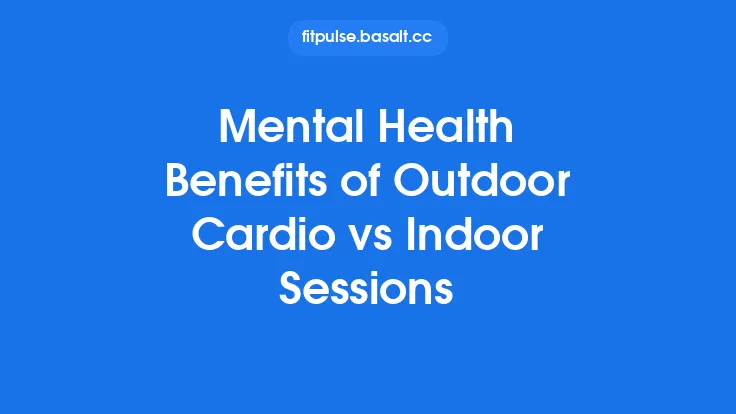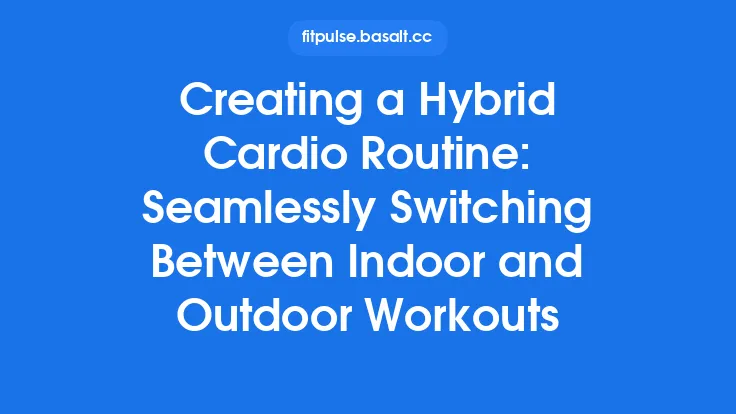Cardiovascular conditioning thrives on consistency, progressive overload, and a clear sense of purpose. While the allure of fresh air and changing scenery can be a powerful draw, there are moments when the indoor environment becomes the catalyst for sustained motivation and measurable progress. Understanding the nuanced reasons to favor indoor cardio sessions can help athletes, busy professionals, and fitness enthusiasts design a routine that aligns with their goals, lifestyle, and psychological triggers.
Understanding the Role of Motivation in Cardio Training
Motivation is not a monolithic force; it fluctuates based on internal states (energy levels, mood, stress) and external circumstances (time of day, environment, social context). In the realm of cardio, motivation often hinges on two primary drivers:
- Goal‑Oriented Motivation – The desire to achieve specific performance metrics such as a target VO₂ max, a particular heart‑rate zone duration, or a set distance.
- Process‑Oriented Motivation – The enjoyment derived from the act of training itself, including the rhythm of movement, the music, or the immersive experience of a virtual class.
When either driver is compromised by unpredictable external factors, the indoor setting can restore the balance, providing a stable platform where the athlete can focus on the process and chase the goal without unnecessary distractions.
When Consistency Trumps Variety: The Power of a Controlled Environment
A controlled indoor climate eliminates the day‑to‑day variability that can sabotage training plans. Consider the following physiological implications:
- Stable Temperature & Humidity – Thermoregulation is a major determinant of perceived exertion. In a room kept at 68–72 °F (20–22 °C) with moderate humidity, the body can maintain core temperature more efficiently, allowing athletes to stay within their target heart‑rate zones for longer periods.
- Predictable Airflow – Consistent ventilation reduces the risk of sudden spikes in respiratory strain, which can otherwise cause premature fatigue and demotivation.
- Uniform Surface – A treadmill belt or stationary bike provides a consistent mechanical load, ensuring that stride length, pedal cadence, and impact forces remain constant across sessions. This uniformity is essential for tracking incremental improvements in metrics such as lactate threshold or running economy.
By removing these variables, the indoor environment supports a repeatable stimulus, which is crucial for progressive overload—a cornerstone of long‑term cardiovascular development.
Time Constraints and Scheduling Flexibility
Modern life rarely adheres to a 9‑to‑5 schedule, and cardio motivation can quickly erode when workouts must be squeezed around unpredictable commitments. Indoor cardio offers several time‑saving advantages:
- Zero Commute – No need to travel to a park, trail, or track. The workout can begin the moment you step onto the equipment, reducing friction and the mental cost of “getting out the door.”
- Micro‑Sessions – Short, high‑intensity intervals (e.g., 10 × 30 seconds on a stationary bike) can be performed in a living room or office break area, making it easier to accumulate weekly volume without a large time block.
- Multi‑Tasking Compatibility – Many indoor setups allow for simultaneous activities such as watching educational content, attending a virtual class, or even handling light work tasks, thereby integrating cardio into otherwise idle periods.
When the primary barrier to training is “lack of time,” the convenience of indoor cardio can reignite motivation by aligning the workout with the athlete’s existing schedule rather than forcing the schedule to accommodate the workout.
Leveraging Technology and Data for Motivation
The digital age has turned cardio training into a data‑rich experience. Indoor cardio platforms excel at delivering real‑time feedback that fuels intrinsic motivation:
- Heart‑Rate Zone Monitoring – Devices integrated with treadmills, ellipticals, or rowing machines can display instantaneous zone percentages, helping athletes stay within the desired aerobic or anaerobic thresholds.
- Power Output & Cadence Metrics – Stationary bikes equipped with power meters provide objective measures of work (watts) and cadence (rpm), enabling precise pacing and progressive overload.
- Performance Dashboards – Apps such as Zwift, Peloton, or proprietary console software compile session histories, trend graphs, and achievement badges, turning each workout into a quantifiable milestone.
- Gamified Challenges – Virtual leaderboards, community rides, and achievement unlocks create a competitive yet supportive environment that can sustain motivation over the long term.
When motivation is driven by measurable progress, the indoor setting’s ability to capture and display data in real time becomes a decisive advantage.
Privacy and Personal Comfort as Motivational Drivers
Not every athlete feels comfortable exercising in public spaces. Concerns about self‑consciousness, body image, or simply a preference for solitude can dampen the desire to train outdoors. Indoor cardio addresses these concerns:
- Controlled Auditory Environment – The ability to curate a personal soundtrack without external noise interference can enhance focus and enjoyment.
- Visual Privacy – A home gym or private studio eliminates the feeling of being observed, allowing athletes to experiment with form, intensity, or new equipment without judgment.
- Customizable Ambiance – Lighting, temperature, and even scent can be tailored to create a mood that aligns with the athlete’s mental state, fostering a more inviting training atmosphere.
When personal comfort translates into reduced psychological barriers, the likelihood of initiating and completing a cardio session rises dramatically.
Specific Training Goals That Favor Indoor Settings
Certain cardiovascular objectives are inherently more suited to indoor execution:
| Goal | Why Indoor Works Best |
|---|---|
| Precise VO₂ Max Testing | Laboratory‑grade treadmills provide calibrated speed and incline, essential for accurate maximal oxygen uptake assessments. |
| Interval Training with Exact Work‑Rest Ratios | Programmable machines can automatically adjust speed, resistance, or incline, ensuring strict adherence to interval prescriptions. |
| Low‑Impact Cardio for Rehabilitation | Ellipticals and rowing machines allow for controlled joint loading, facilitating recovery while still delivering cardiovascular stimulus. |
| High‑Intensity Sprint Intervals | Treadmills with rapid acceleration capabilities enable repeatable sprint bouts without the need for flat, safe outdoor surfaces. |
| Altitude or Heat Simulation | Some indoor equipment offers environmental chambers or adjustable fan settings to mimic altitude or heat stress, useful for specific training adaptations. |
When the training goal demands exact control over variables such as speed, resistance, or environmental stressors, the indoor environment becomes the logical choice for maintaining motivation and achieving the desired outcome.
Managing Physical Discomfort and Fatigue
Physical discomfort—whether from heat, wind, or uneven terrain—can quickly erode motivation. Indoor cardio mitigates these factors:
- Thermal Comfort – Air‑conditioned rooms prevent overheating, reducing the perceived exertion that often leads to early termination of a session.
- Reduced Impact Stress – Shock‑absorbing treadmill decks or cushioned elliptical footplates lower joint loading, allowing longer duration workouts with less post‑exercise soreness.
- Consistent Surface – Uniform tread or pedal resistance eliminates the need for constant micro‑adjustments in stride or pedal stroke, conserving energy for the intended cardiovascular stimulus.
By minimizing extraneous physical stressors, athletes can maintain a higher quality of effort, which in turn sustains motivation throughout the workout.
Psychological Cueing and Habit Formation Indoors
Habit formation relies on a reliable cue‑routine‑reward loop. Indoor cardio excels at establishing each component:
- Cue – A designated workout space, a specific time of day, or a pre‑programmed equipment start-up sequence serves as a clear trigger.
- Routine – The predictable environment reduces decision fatigue, allowing the athlete to transition seamlessly into the cardio routine.
- Reward – Immediate feedback (e.g., a post‑session summary, a celebratory badge, or a favorite playlist) reinforces the behavior.
Because the indoor setting can be meticulously arranged to repeat these cues, it becomes a powerful engine for building lasting cardio habits, especially for individuals who struggle with the variability of outdoor conditions.
Adapting to Life Transitions and Seasonal Changes
Life events—relocations, new work schedules, or seasonal shifts—often disrupt outdoor training patterns. Indoor cardio offers a resilient fallback:
- Season‑Independent Training – Whether it’s a scorching summer or a frigid winter, the indoor climate remains constant, preventing seasonal motivation dips.
- Space Flexibility – Portable equipment (foldable treadmills, compact rowing machines) can be moved between apartments, dorms, or temporary housing, ensuring continuity.
- Travel Compatibility – Many hotels and gyms provide cardio machines, allowing athletes to maintain their routine while on the road, preserving momentum.
When external circumstances threaten to interrupt a training regimen, the indoor option provides a stable anchor that helps preserve motivation and performance gains.
Integrating Indoor Sessions into a Sustainable Cardio Plan
To maximize the motivational benefits of indoor cardio without falling into monotony, consider the following strategic framework:
- Periodize the Environment – Allocate blocks of weeks where the primary stimulus is indoor (e.g., 4‑week “controlled phase”) followed by a transition to outdoor sessions for variety.
- Mix Modality Within the Same Space – Alternate between treadmill, elliptical, rowing, and stationary bike to engage different muscle groups and prevent mental fatigue.
- Leverage Structured Programming – Use evidence‑based plans (e.g., 3‑4 interval sessions per week, 2 steady‑state rides) that prescribe specific intensity zones, ensuring each indoor workout has a clear purpose.
- Incorporate Progressive Overload – Incrementally increase speed, incline, resistance, or duration each week, using the precise data available from indoor equipment to track progress.
- Schedule “Motivation Check‑Ins” – Every 2–4 weeks, review performance dashboards, adjust goals, and celebrate milestones to reinforce the reward component of the habit loop.
By embedding indoor cardio within a broader, periodized training architecture, athletes can harness its motivational strengths while still enjoying the benefits of outdoor variety when circumstances allow.
Bottom line: Indoor cardio is not merely a fallback for bad weather; it is a strategic tool that, when employed thoughtfully, can amplify motivation, ensure consistency, and accelerate cardiovascular gains. By recognizing the specific scenarios—time pressure, need for precise data, desire for privacy, or requirement for controlled physiological stress—where the indoor environment excels, athletes can make informed decisions that keep them moving forward, regardless of external circumstances.





